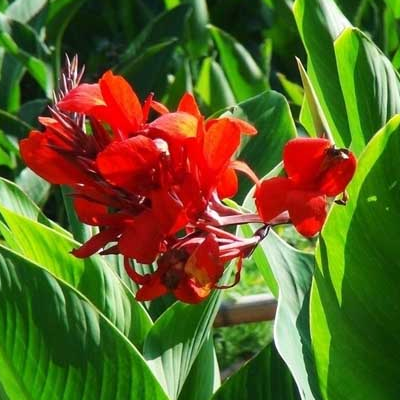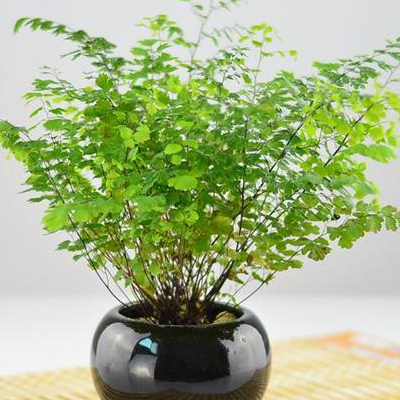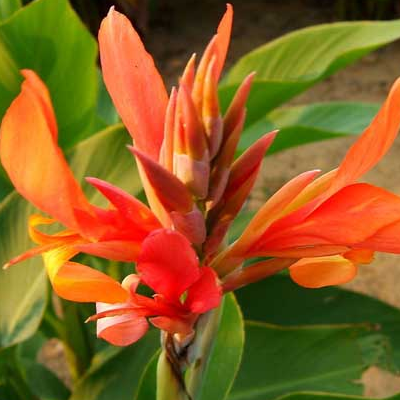When will the culture method of canna blossom
Canna has a long history of cultivation in China, originated in America and India, and later widely planted in China. How to cultivate canna? When does the canna bloom?

The culture method of canna:
Canna belongs to the genus Canna of the Canna family. Also known as red banana, Tanhua, popcorn, ginger. Native to the tropics of America and India. At present, it is widely cultivated in the north and south of China, but it can not be overwintered in the north of Hunan Province. Canna has a long history of cultivation in China, which is known as red banana in ancient times. Because of its large green leaves, bright and beautiful colors, tenacious and straight plants, vigorous growth and extensive management, it has always been loved by people. "the leaves of the banana leaves are far away, the calyx is high and the sun is red, like a beauty sleeping in spring, crimson lips and green sleeves dancing in the east wind." Hence the name of Canna.
I. Culture environment of canna
1, like warm and humid climate, not resistant to frost, suitable temperature 25-30 ℃, like sufficient sunshine fertile land, no dormancy in the origin, annual growth and flowering; strong sex, strong adaptability, almost no choice of soil, moist and fertile loose sandy soil is better, slightly resistant to water and moisture. Afraid of the strong wind. After planting after frost in April-May in spring, the top of the stem formed flower bud after germination, and the floret opened from bottom to top. In the growing season, the pressure of Reagan stem germinated one after another to form a new stem, which blossomed continuously from June to Frosts Descent, and the total flowering period was long. The rhizome overwinters in the south of the Yangtze River, and the north of the Yangtze River must be protected artificially.
2. Canna is not resistant to cold and is afraid of strong wind and frost. It is not strict with the soil, can withstand barren, and grows well in fertile, moist and well-drained soil. After the plant withered in late autumn, cut off the aboveground part, dig out the rhizome, dry it for 2 minutes, bury it in the well-ventilated sand in the greenhouse, do not water it, and keep it for more than 5 ℃ to survive the winter safely.
II. Land planting management of canna
After late autumn, usually from the end of October to the beginning of November, the leaves and flowers begin to turn yellow, then the roots and stems can be dug out, cut off the upper branches and leaves, and placed in a non-freezing room, or buried in a sunny leeward cellar in the courtyard, keeping the temperature at 5: 8 ℃. Check 2-3 times during overwintering to prevent heat or freezing. After no frost in the spring of the following year, the rhizome was divided and planted separately. In the south of the Yangtze River basin, the roots do not need to be dug up in winter, but can be dug out and planted in the following spring when new buds grow. After planting, always keep the soil moist, loosen the soil and weed in time. During the growing period, it can be combined with watering and topdressing for 2 or 3 times to promote robust growth.
III. Pot management of canna
Dwarf varieties should be selected for potted canna. The potted soil should be fertile. Plant 2-3 buds in each pot, pour water after planting, and place them in a place with plenty of light. Topdressing liquid fertilizer before flowering. In the growing period, often keep the basin soil moist, more cake fertilizer and water, can make the plant growth exuberant, luxuriant leaves.
IV. Disease and pest control of canna
Canna has strong adaptability and few diseases and insect pests, and it is very easy to cultivate. the main diseases and insect pests are leaf rollers, ground tigers and so on.
1. Leaf curlers
[insect pest symptoms] from May to August every year, it is easy to cause harm to leaf curlers, mainly to tender leaves and inflorescences, and curl after being killed.
[control method] ① sprayed 800x solution of dichlorvos at 50 latitudes. ② sprays 50% fenitrothion EC 1000 times.
2. Ground tiger
[pest symptoms] planting canna occasionally occurs in tigers.
[control method] ① was captured manually early in the morning. ② perfused the root soil with trichlorfon 600 ~ 800 times solution.
When will canna blossom:
Canna is a perennial bulbous herbaceous flower with more than 50 varieties such as milky white, bright yellow, orange, orange, pink, bright red, purple and complex spots. The florescence is usually from June to October in the north and blossoms throughout the year in the south.
Canna has large and colorful flowers, rich colors, good plant shape, easy cultivation and high ornamental value. It can be potted or planted on the ground. Many people like to keep them in the courtyard, which can purify the air and protect the environment. It is an ideal flower for greening, beautifying and purifying the environment.
All right, guys, you all know how long the florescence is.
How to cultivate Canna Canna Culture methods and skills
There may not be many people growing canna, but in fact, planting canna requires some attention. Next, let's introduce the culture method of canna to you.
Culture methods of canna
I. the culture method of canna-- morphology
Canna is a relatively low plant with a beautiful shape and a variety of colors. The viewing degree of canna is extremely high, and it is very beautiful surrounded by dense clusters.
Second, the culture method of canna-- habit
Canna likes the high temperature environment, and the humid and hot climate is suitable for growing canna. The temperature of canna should be controlled at about 32 degrees Celsius. Once the ambient temperature is lower than 20 degrees, the flowers will be less likely to bloom. When the temperature is lower than 0 degrees, the problem of freezing injury will occur slowly.
Third, the culture method of canna-sowing
Canna can be collected in winter to ensure that it is most appropriate to sow in spring. Winter seeds need a warm environment to keep warm and prevent frost damage, and it is best to sow seeds and wait for germination at warmer temperatures. The general time of germination is about 25 days.
IV. The culture method of canna-cutting
Canna can also choose cutting methods. Spring and summer is a good time for cutting. Choose strong branches, which are about 10 centimeters long. Plant them in an acid sand bed and wait for 40 to 50 days to slowly take root. Pay attention to insect pests.
Cultivation methods of canna under light
Canna growth should be full-day sunshine, the environment is too dark, lack of light, the flowering period will be delayed. If you put it in a cool place during flowering, you can prolong the flowering period.
Temperature
The suitable growth temperature of canna is 15 ℃-30 ℃. During flowering, placing canna in a place with low temperature and no light can prolong the flowering period, and the ambient temperature should not be lower than 10 ℃.
When the temperature is above 40 ℃, the canna can be moved to a cool and ventilated place. Before and after Frosts Descent, the potted canna can be moved to a temperature of 5-10 ℃ to survive the winter safely.
Watering
During the growing period, canna needs to spray water on its leaves 1-2 times a day to maintain humidity.
Because canna is very fond of fertilizer and moisture resistance, so the basin should be watered thoroughly, and the watering times should be grasped according to the actual situation.
Fertilizer application
Apply sufficient basal fertilizer before planting, in addition, topdressing 3mi 4 times a month during the peak growth period.
Soil
Canna does not have high requirements for soil, but it grows best in loose, fertile and well-drained sandy soil, even in fertile clayey soil.
The above is about the introduction of canna flower language and breeding methods, to learn more, please pay attention to the four Seasons Plant Network!
- Prev

What about the long spores on the back of the leaves of Dryopteris Dryopteris? what are the breeding methods?
Dryopteris is very suitable as an indoor ornamental plant, and it is also a favorite of many people, so what about the long spores on the back of the fern leaves? What are the breeding methods of Dryopteris? What about the long spores on the back of the leaves of Dryopteris: 1. The spore does not grow much, but it will fall off when it is about to mature.
- Next

How much is the banana pot? what are the culture techniques in a pot?
Canna is a perennial perennial herb, native to Anglo-American and India, and later widely planted in China, so how much is it per pot? What are the techniques of canna pot culture? How much is the canna plant per pot: the sapling of canna is 0.4 yuan per plant, which is still relatively cheap.
Related
- Fuxing push coffee new agricultural production and marketing class: lack of small-scale processing plants
- Jujube rice field leisure farm deep ploughing Yilan for five years to create a space for organic food and play
- Nongyu Farm-A trial of organic papaya for brave women with advanced technology
- Four points for attention in the prevention and control of diseases and insect pests of edible fungi
- How to add nutrient solution to Edible Fungi
- Is there any good way to control edible fungus mites?
- Open Inoculation Technology of Edible Fungi
- Is there any clever way to use fertilizer for edible fungus in winter?
- What agents are used to kill the pathogens of edible fungi in the mushroom shed?
- Rapid drying of Edible Fungi

